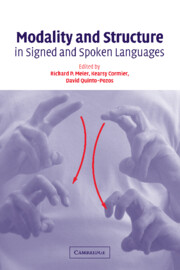Book contents
- Frontmatter
- Contents
- List of figures
- List of tables
- List of contributors
- Acknowledgements
- 1 Why different, why the same? Explaining effects and non-effects of modality upon linguistic structure in sign and speech
- Part I Phonological structure in signed languages
- Part II Gesture and iconicity in sign and speech
- 7 A modality-free notion of gesture and how it can help us with the morpheme vs. gesture question in sign language linguistics (Or at least give us some criteria to work with)
- 8 Gesture as the substrate in the process of ASL grammaticization
- 9 A crosslinguistic examination of the lexicons of four signed languages
- Part III Syntax in sign: Few or no effects of modality
- Part IV Using space and describing space: Pronouns, classifiers, and verb agreement
- Index
- References
8 - Gesture as the substrate in the process of ASL grammaticization
Published online by Cambridge University Press: 22 September 2009
- Frontmatter
- Contents
- List of figures
- List of tables
- List of contributors
- Acknowledgements
- 1 Why different, why the same? Explaining effects and non-effects of modality upon linguistic structure in sign and speech
- Part I Phonological structure in signed languages
- Part II Gesture and iconicity in sign and speech
- 7 A modality-free notion of gesture and how it can help us with the morpheme vs. gesture question in sign language linguistics (Or at least give us some criteria to work with)
- 8 Gesture as the substrate in the process of ASL grammaticization
- 9 A crosslinguistic examination of the lexicons of four signed languages
- Part III Syntax in sign: Few or no effects of modality
- Part IV Using space and describing space: Pronouns, classifiers, and verb agreement
- Index
- References
Summary
Introduction
Grammaticization is the diachronic process by which:
lexical morphemes in a language, such as nouns and verbs, develop over time into grammatical morphemes; or
morphemes less grammatical in nature, such as auxiliaries, develop into ones more grammatical, such as tense or aspect markers (Bybee et al. 1994).
Thus any given grammatical item, even viewed synchronically, is understood to have an evolutionary history. The development of grammar may be traced along grammaticization pathways, with vestiges of each stage often remaining in the current grammar (Hopper 1991; Bybee et al. 1994), so that even synchronically, lexical and grammatical items that share similar form can be shown to be related. Grammaticization is thought to be a universal process; this is how grammar develops. Bybee et al. claim that this process is regular and has predictable evidence, found in the two broad categories of phonology and semantics. Semantic generalization occurs as the more lexical morpheme loses some of its specificity and, usually along with a particular construction it is found within, can be more broadly applied. Certain components of the meaning are lost when this generalization takes place. Regarding phonological change, grammaticizing elements and the constructions they occur in tend to undergo phonological reduction at a faster rate than lexical elements not involved in grammaticization.
The ultimate source of grammaticized forms in languages is understood to be lexical. Most commonly, the source categories are nouns and verbs. Thus, the origins of numerous grammatical elements, at least for spoken languages, are former lexical items.
- Type
- Chapter
- Information
- Modality and Structure in Signed and Spoken Languages , pp. 199 - 223Publisher: Cambridge University PressPrint publication year: 2002
References
- 52
- Cited by



